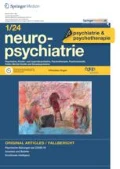Summary
Background
The comorbidity of attention deficit hyperactivity disorder (ADHD) and schizophrenia poses a considerable diagnostic challenge due to significant symptom overlap, and represents a highly debilitating condition for the patient. This case report aims to present the history of a 19-year-old patient suffering from these two diagnostic entities, and thereby seeks to elucidate diagnostic and therapeutic approaches for this condition.
Methods
The Diagnostic and Statistical Manual of Mental Disorders (fourth edition) criteria for ADHD and schizophrenia were used to establish clinical diagnoses. Furthermore, an in-depth clinical interview with the patient’s mother was carried out. Finally, a clinical interview was conducted with the patient and the Wender Utah Rating Scale was applied to assess ADHD symptoms retrospectively.
Results
Outcomes of the mentioned diagnostic approaches confirmed the diagnosis of ADHD in the patient suffering from schizophrenia. As amphetamines would be contraindicated in the described patient, atomoxetine, a drug approved for the treatment of ADHD due to its efficacy as a selective norepinephrine reuptake inhibitor, was chosen. Following a 6-week interval after treatment initiation, a clinical re-evaluation was carried out, which showed an improvement of symptoms according to the International Classification of Diseases (tenth revision) criteria.
Conclusion
The present case report indicates that atomoxetine may be effective in treating symptoms of ADHD in patients with schizophrenia, without increasing psychotic symptoms. Results are discussed in terms of diagnostic and therapeutic implications.
Zusammenfassung
Hintergrund
Die Komorbidität von ADHS und Schizophrenie stellt aufgrund von Symptomüberlappung eine erhebliche diagnostische Herausforderung dar und ist für den Patienten eine stark beeinträchtigende Bedingung. Der vorliegende Fallbericht setzt sich zum Ziel, die Anamnese eines neunzehnjährigen Patienten, der unter den erwähnten zwei diagnostischen Entitäten leidet, darzustellen und dadurch diagnostische und therapeutische Herangehensweisen darzulegen.
Methoden
DSM-IV Kriterien für ADHD und Schizophrenie wurden herangezogen, um die klinischen Diagnosen zu erstellen. Überdies wurde ein klinisches Interview mit der Mutter des Patienten durchgeführt. Schließlich wurde auch mit dem Patienten ein klinisches Interview durchgeführt sowie die Wender Utah Rating Scale angewandt, um retrospektiv ADHD Symptome zu erfassen.
Ergebnisse
Die Ergebnisse der erwähnten diagnostischen Zugänge bekräftigten die Diagnose von ADHD bei jenem Patienten mit Schizophrenie. Da die Verabreichung von Amphetaminen bei beschriebenem Patienten kontraindiziert ist, wurde Atomoxetin, ein Medikament, das für die Behandlung von ADHD aufgrund seiner Wirksamkeit als selektiver Noradrenalin-Wiederaufnahme-Hemmer zugelassen ist, verwendet. Nach einem sechswöchigen Intervall nach Behandlungsbeginn wurde eine klinische Re-evaluierung durchgeführt, die eine Symptomverbesserung nach ICD 10 Kriterien zeigte.
Schlussfolgerung
Der vorliegende Fallbericht beschreibt, dass Atomoxetin in der Behandlung von ADHD Symptomen bei Patienten mit Schizophrenie wirksam sein kann, ohne psychotische Symptome zu steigern. Die Ergebnisse werden in Bezug auf diagnostische und therapeutische Implikationen diskutiert.
References
Kooij SJ, Bejerot S, Blackwell A, et al. European consensus statement on diagnosis and treatment of adult ADHD: the European Network Adult ADHD. BMC Psychiatry. 2010;10:67.
Hill JC, Schoener EP. Age-dependent decline of attention deficit hyperactivity disorder. Am J Psychiatry. 1996;153(9):1143–6.
Faraone SV, Biederman J, Mick E. The age-dependent decline of attention deficit hyperactivity disorder: a meta-analysis of follow-up studies. Psychol Med. 2006;36(2):159–65.
Simon V, Czobor P, Balint S, Meszaros A, Bitter I. Prevalence and correlates of adult attention-deficit hyperactivity disorder: meta-analysis. Br J Psychiatry. 2009;194(3):204–11.
Sandra Kooij JJ, Marije Boonstra A, Swinkels SH, Bekker EM, de Noord I, Buitelaar JK. Reliability, validity, and utility of instruments for self-report and informant report concerning symptoms of ADHD in adult patients. J Atten Disord. 2008;11(4):445–58.
Prince JB. Pharmacotherapy of attention-deficit hyperactivity disorder in children and adolescents: update on new stimulant preparations, atomoxetine, and novel treatments. Child Adolesc Psychiatr Clin N Am. 2006;15(1):13–50.
Meszaros A, Czobor P, Balint S, Komlosi S, Simon V, Bitter I. Pharmacotherapy of adult attention deficit hyperactivity disorder (ADHD): a meta-analysis. Int J Neuropsychopharmacol. 2009;12(8):1137–47.
Biederman J. Impact of comorbidity in adults with attention-deficit/hyperactivity disorder. J Clin Psychiatry. 2004;65(Suppl. 3):3–7.
Hallerbäck MU, Lugnegård T, Gillberg C. ADHD and nicotine use in schizophrenia and Asperger syndrome: a controlled study. J Atten Disord. 2012. Epub ahead of print.
Donev R, Gantert D, Alawam K, et al. Comorbidity of schizophrenia and adult attention-deficit hyperactivity disorder. World J Biol Psychiatry. 2011;12(Suppl. 1):52–6.
Karatekin C, White T, Bingham C. Shared and nonshared symptoms in youth-onset psychosis and ADHD. J Atten Disord. 2010;14(2):121–31.
Ward MF, Wender PH, Reimherr FW. The Wender Utah Rating Scale: an aid in the retrospective diagnosis of childhood attention deficit hyperactivity disorder. Am J Psychiatry. 1993;150(6):885–90.
Havik B, Degenhardt FA, Johansson S, et al. DCLK1 variants are associated across schizophrenia and attention deficit/hyperactivity disorder. PLoS One. 2012;7(4):e35424.
Peralta V, de Jalon EG, Campos MS, Zandio M, Sanchez-Torres A, Cuesta MJ. The meaning of childhood attention-deficit hyperactivity symptoms in patients with a first-episode of schizophrenia-spectrum psychosis. Schizophr Res. 2011;126(1–3):28–35.
Kraemer M, Uekermann J, Wiltfang J, Kis B. Methylphenidate-induced psychosis in adult attention-deficit/hyperactivity disorder: report of 3 new cases and review of the literature. Clin Neuropharmacol. 2010;33(4):204–6.
Bymaster FP, Katner JS, Nelson DL, et al. Atomoxetine increases extracellular levels of norepinephrine and dopamine in prefrontal cortex of rat: a potential mechanism for efficacy in attention deficit/hyperactivity disorder. Neuropsychopharmacology. 2002;27(5):699–711.
Tossell JW, Greenstein DK, Davidson AL, et al. Stimulant drug treatment in childhood-onset schizophrenia with comorbid ADHD: an open-label case series. J Child Adolesc Psychopharmacol. 2004;14(3):448–54.
Acknowledgments
The authors thank the patient for allowing them to publish his case report. The authors are grateful for the proof reading of the manuscript by Anne Unger.
Conflict of interest
Julia Huemer and Ingrid Sibitz report no conflict of interest.
Author information
Authors and Affiliations
Corresponding author
Rights and permissions
About this article
Cite this article
Huemer, J., Sibitz, I. Detecting and treating adult attention deficit hyperactivity disorder in a patient with schizophrenia. Neuropsychiatr 28, 92–96 (2014). https://doi.org/10.1007/s40211-014-0103-0
Received:
Accepted:
Published:
Issue Date:
DOI: https://doi.org/10.1007/s40211-014-0103-0

